| Article ID | Journal | Published Year | Pages | File Type |
|---|---|---|---|---|
| 6455051 | Applied Catalysis B: Environmental | 2017 | 8 Pages |
â¢The different metal-ion-doped K-OMS-2 catalysts showed distinct differences in their ozone decomposition activity.â¢Co3+ and Fe3+ replace the Mn3+in the cryptomelane structure and Ce4+ mainly replace the K+ in the tunnel and partially replace the Mn4+ in the cryptomelane structure.â¢The morphology of Ce-OMS-2 is extremely different from the other M-OMS-2 catalysts.â¢Ce-OMS-2 is promising for decomposing ozone under high-humidity conditions.â¢The Mn3+content and number of surface defects play a key role during the decomposition of ozone.
Transition metal (Cerium, Cobalt, and Iron) doped cryptomelane-type manganese oxide (M-OMS-2) catalysts have been successfully synthesized and characterized. The different metal-ion-doped K-OMS-2 catalysts showed distinct differences in their ozone decomposition activity. Cerium-doped OMS-2 materials showed ozone conversion of 90% under RHÂ =Â 90% and space velocity of 600,000Â hâ1. X-ray diffraction (XRD), thermogravimetric analysis (TGA), and X-ray photoelectron spectroscopy (XPS) data suggested that the as-synthesized M-OMS-2 materials were all crystalline with no segregated metal oxide impurities. ICP-OES and XAFS results confirmed that Co3+ and Fe3+ replace Mn3+ in the cryptomelane structure and Ce4+mainly replaces the K+ in the tunnel and partially replaces the Mn4+ in the framework of the cryptomelane structure. Because of the differences in the substitution sites and the ionic radius of dopants, the morphologies of the catalysts were different. The Mn3+content and number of surface defects play a key role during the decomposition of ozone. Ce-OMS-2 is a promising catalyst for purifying waste gases containing ozone under high-humidity conditions.
Graphical abstractDownload high-res image (302KB)Download full-size image
